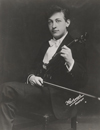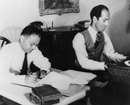All material found in the Press Releases section is provided by parties entirely independent of Musical America, which is not responsible for content.
Press Releases
Rhapsody in Blue 1924 Version Released in Recording
Dr. Ryan Banagale's Arranging Gershwin: Rhapsody in Blue and the Creation of an American Icon (Oxford University Press, 2014), focuses on the ongoing-and surprising-life of Gershwin's iconic "Rhapsody in Blue" over the course of the ninety years since its inception. His 2011 Ph.D. dissertation at Harvard University is titled, "Rhapsodies In Blue: New Narratives for an Iconic American ‘Composition’". Dr. Banagale's critical edition of "Rhapsody in Blue" receives its first recording release on August 27, 2021, featuring pianist Jeffrey Biegel, joined with the Adrian Symphony Orchestra and Maestro Bruce Anthony Kiesling. The new recording can be found at the following website with links to the digital download recording. (A limited run of physical CDs will be available shortly as well).
https://jeffreybiegel.hearnow.com/rhapsody-in-blue-1924-version
According to Mr. Biegel: "I have performed the many guises of 'Rhapsody in Blue' since the age of nine. In 1997, when performing the Annotated Rhapsody in Blue, arranged by Dr. Alicia Zizzo, which owns many sections of missing piano material from original sources, I had questioned the Gershwin family about having a new edition with the original orchestral material and the piano material together. Here we are, and it is now available, thanks to many involved. It is truly an honor to have the permissions necessary to make this recording happen, as well as generous donor support to bring this recording to life for today's listeners and for historic purpose."
According to the Gershwin Initiative at the University of Michigan website:
The University of Michigan Gershwin Initiative will be an ongoing scholarly examination of the Gershwins’ music, in which U-M scholars in collaboration with peers from across the nation and globe will document and analyze—note-by-note and word-by-word—the treasure trove of works featuring music by George Gershwin and lyrics by Ira Gershwin—including Porgy and Bess, often considered America’s greatest opera—as well as the celebrated instrumental works by George Gershwin. The basis for the Gershwin Initiative is a new and complete critical edition to be published in book and electronic forms through European American Music and Schott International. Each volume will contain an introductory essay concentrating on the genesis of the compositions included, as well as critical commentary that explains any editorial decisions made to present the Gershwins’ work. This commentary invites artists to engage more authoritatively with the music as interpreters. The second part of the Initiative will include a variety of courses and musical performances designed to bring the Gershwins’ art to students at the School of Music, Theatre & Dance and, indeed, across campus.
Remarkably, the Gershwins’ works have never received the benefit of scholarly editing, partially due to George Gershwin’s premature and tragic death from a brain tumor at age 38. While readily accessible in print and recordings, the scores and parts to many Gershwin works circulate in substandard editions—often hard-to-read photocopies of handwritten scores—that contain notational errors and confusing inconsistencies. Even such notable scores as Porgy and Bess and Rhapsody in Blue circulate in problematic editions that diminish performances by wasting rehearsal time, at best, and, at worst, causing performance errors.
This substantial and historically significant partnership between the Gershwin families and U-M was initiated by Todd Gershwin, a U-M alumnus who is the grandnephew of George and Ira Gershwin and the son of Marc George Gershwin. The project will be overseen by Mark Clague, U-M associate professor of musicology and director of research, who will serve as editor-in-chief of the George and Ira Gershwin Critical Edition.
The Gershwin Critical Edition will be the first-ever scholarly edition of the music and lyrics of George and Ira Gershwin. It will give conductors, musicians, performers, scholars and audiences greater insight into the Gershwins’ original material and, in many cases, offer the first performance materials to accurately reflect the creators’ vision. In addition to Porgy and Bess, famous works to be included in the scholarly review include George Gershwin’s Rhapsody in Blue, An American in Paris, Concerto in F, and Cuban Overture, along with the scores that the brothers wrote together for more than two dozen Broadway and Hollywood musicals, resulting in some of the most recognizable and beloved songs in American music history. Among the dozens of immensely popular songs they crafted together were “I Got Rhythm,” “ ‘S Wonderful,” “Embraceable You,” “Funny Face,” “They Can’t Take That Away From Me,” and “Love is Here to Stay,” just to name a few.
A critical edition combines the best of historical research with the best of editorial accuracy and tradition to produce an edition that represents the authors’ work in as definitive a form as possible. There are critical editions of the plays of Shakespeare, the symphonies of Beethoven, and the poems of E. E. Cummings.
It differs from a standard edition or anthology mainly because the critical edition explains the choices made in its creation. Standard editions present a text but fail to explain the many and inevitable decisions made by editors. With essays, editorial policy statements and explanatory notes, the critical edition invites users to understand the artistry of authors more deeply.
The Gershwins’ music requires careful editing as it combines classical music, jazz, blues and popular song—artistic traditions with very different conventions of musical notation. In an art form like jazz, based on improvisation, notation in transcription is often done after the performance or the playing of the notes. A notated solo by bebop saxophonist Charlie Parker, for instance, would be recognized by his trademark phrases and musical gestures, but it would be the creation of a transcriptionist, rather than the composer. Some of George Gershwin’s most famous works, such as the piano part to “Rhapsody in Blue”, were only written down after their premiere.
In the case of George Gershwin, who often composed quickly and created versions for a variety of ensembles and contexts, current published editions contain numerous errors of notes and even inconsistencies in the numbers of measures. Scholars will determine precisely what should be included on the page to best represent the creators’ work.
More information about the Gershwin Initiative can be found at: https://smtd.umich.edu/ami/gershwin/?page_id=713
More information about the Adrian Symphony Orchestra can be found at: https://www.adriansymphony.org/
More information about Bruce Anthony Kiesling can be found at: http://bruceanthonykiesling.com/
More information about Dr. Ryan Banagale can be found at: https://www.coloradocollege.edu/basics/contact/directory/people/banagale_ryan_raul.html
More information about Jeffrey Biegel can be found at: https://jeffreybiegel.com/





 FEATURED JOBS
FEATURED JOBS

 RENT A PHOTO
RENT A PHOTO


